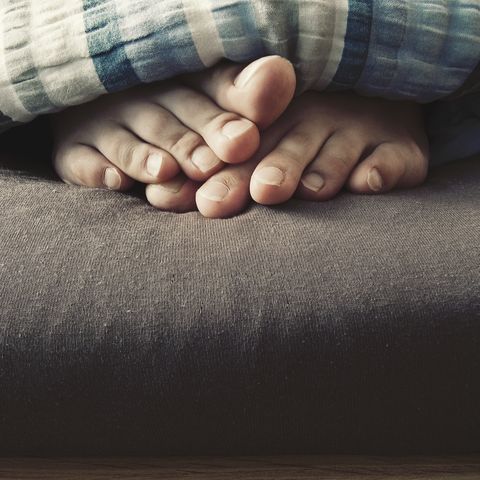
GETTY IMAGESSTOCKIMAGES_AT
What are bunions, anyway?
Bunions are basically deformities of the foot, located at the
joint of your big toe. According to Marco Ucciferri, DPM, a podiatrist at Summit Medical Group in New Jersey, bunions are either arthritic or genetic, and both kinds can cause mild, moderate, or severe pain.
Arthritic bunions are typically caused by some kind of damage or injury (like if you played sports as a kid). Genetic bunions are passed down through families, so if your mom and grandma both had bunions, you probably will, too. Either way, most bunions get bigger as you age, so it’s worth keeping it on your radar even if your bunion isn’t hurting you right now.
But the really important thing to know about bunions? Size does not matter when it comes to pain. “Your pain relates to the amount of pressure you put on the joint and the amount of walking you do regularly,” says Dr. Ucciferri. “You could have a huge bunion that doesn’t bother you, but if you wear dress shoes and walk to work every day, your small bunion could be very painful.”
So yeah, bunions suck...but what can you do to make them suck a little less? Here are eight ways to relieve your bunion pain.
1. Wear the right shoes.
Maybe a no-brainer, but it's a good place to start. Sure, you love the way your calves look in heels, but all that height is probably putting a lot of pressure on your toe joints, including the one with the bunion.
Dr. Ucciferri says that switching up your footwear of choice—like wearing rounded-toe styles instead of pointed-toe ones and swapping out your heels for flats—can keep you pain-free. Start with these 7 cute shoes that won't hurt if you have bunions.
2. Get your feet professionally measured.
You might think you wear a size 7 shoe, but heading to your nearest shoe store for a professional sizing could surprise you. Not only could one or both of your feet measure a half-size smaller or bigger than you think, you might also have wide feet that are just plain suffering inside your narrow dress shoes. Getting your feet sized, says Dr. Ucciferri, can be an eye-opening experience that makes it way more comfortable to pound the pavement on a daily basis.
3. Use an orthotic device.
If you’re looking for really stellar foot support and want to alleviate the constant pressure on your big toe joint, you might want to ask your podiatrist about a custom-made orthotic device. After creating a cast of your foot, your doctor can make a device based on your individual needs.
“If your foot hurts when you’re walking to work every day, I’ll build an orthotic that you can wear with your dress shoes,” says Dr. Ucciferri. “But if you tell me your foot hurts after you work out at the gym for an hour, I’ll build one for your running shoes or sneakers.”
If you’re not sure about forking over the cash for a custom device, Dr. Ucciferri says you can try an over-the-counter arch support insert first (like
Dr. Scholl’s) to see if it helps before springing for a version made just for you.
4. Ice it,
Your grandma wasn’t totally wrong with all of her foot-soaking: Dr. Ucciferri says that soaking your feet can reduce inflammation of the big toe joint...but you want to use ice water (or apply an ice pack) for best results, not the more traditionally-soothing warm water.
“Soaking your foot in hot water will make it feel better, but it will also make it swell, so it might hurt even more the next day,”
5. Pop some OTC pain relievers.
If you’re looking for quick, reliable relief, Dr. Ucciferri says you can lean on an NSAID like Aleve or Motrin, both of which work well for alleviating acute bunion pain. (Tylenol, which is not an anti-inflammatory, doesn’t quite do the trick here.)
If you find yourself taking NSAIDs every day for bunion pain, though, you should probably ask your doctor for help finding some non-medication remedies, if possible, since taking anti-inflammatories regularly can cause
side effects.
6. Wear a moleskin pad.
This nifty little gel pads are designed to cushion the bunion and reduce friction inside your shoe, which Dr. Ucciferri says can make wearing your favorite kicks a bit more comfortable. Fin
Many moleskin pads can be applied to either your foot or your shoe to prevent painful rubbing, and most can also be cut down to the exact size and shape you need. They’re an affordable option that might reap big-time relief benefits.
7. Consider surgery.
If you’ve stopped walking and exercising regularly or can’t wear most of the shoes in your closet, then you’re letting your bunion rule your life, and you might want to get it removed.
But while the surgery is a pretty simple outpatient procedure, you’ll need anywhere from a few days to a few weeks for recovery, depending on the size of the bunion (and 1 to 2 months before you’re fully recovered and heading back out for your morning run).

 .
.









